Sontheimer Höhle
Cave of Sontheim
Useful Information
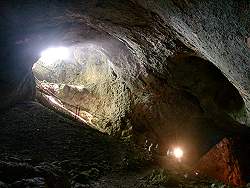
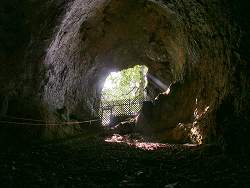
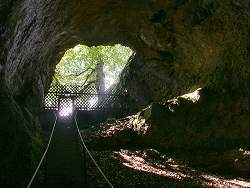
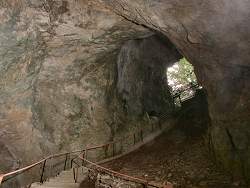
| Location: |
Sontheim, Schwäbische Alb (Swabian Jura).
A8 exit Merklingen, 12 km south to Sontheim. 2 km south of Sontheim, in the Tiefental. Leave the road from the Autobahn and enter Sontheim, follow signs towards Seißen. Follow the road Sontheim-Seißen, after 2 km turn right, 5 min/300 m walk from parking lot. (48.4311774, 9.6838466) |
| Open: |
MAY to JUN Sat 14-17, Sun, Hol 10-17. JUL to AUG Tue-Fri 13-17, Sat 14-17, Sun, Hol 10-17. SEP to OCT Sat 14-17, Sun, Hol 10-17. Tours every hour on the hour. Restaurant: APR to OCT Sat 14-18, Sun, Hol 10-18. [2021] |
| Fee: |
Adults EUR 4, Children (6-14) EUR 3, Children (0-5) free. [2021] |
| Classification: |
 Karst Cave Karst Cave
|
| Light: |
 LED LED
|
| Dimension: | L=530 m, VR=54 m, A=720 m asl Portal: W=7 m, H=12 m. |
| Guided tours: | L=192 m, VR=34 m, D=30 min. |
| Photography: | allowed |
| Accessibility: | no |
| Bibliography: |
Helmut Frank, Erich Ruopp, Herbert Keifer (1997):
Führer durch die Sontheimer Höhle,
4th ed., 41 pp, 17 illus, 1 survey, 1 table.

n.A. (1971): 500 Jahre Sontheimer Höhle Pfingsten 1971, 
|
| Address: |
Höhlenverein Sontheim e.V., Kohlhalde 1, 72535 Heroldstadt, Tel: +49-7389-906109.
E-mail: Cave entrance, Tel: +49-7389-906648 (only during open hours). Weekdays appointments, Tel: +49-7389-906404. E-mail: |
| As far as we know this information was accurate when it was published (see years in brackets), but may have changed since then. Please check rates and details directly with the companies in question if you need more recent info. |
|
History
| 3rd/4th century | early alemannic grave inside the cave. |
| 1488 | first description of the cave by Fabri, the prior of the Dominicans in Ulm. |
| 20-OCT-1516 | visit by Herzog Ulrich von Württemberg, the sovereign of this area. |
| 1753 | description and first map by Prälat Weissensee. |
| 1791 | description by Rössler. |
| 1823 | description by Gustav Schwab, a famous German historian. |
| 03-JUL-1825 | first big cave celebration which revived the old tradition of cave celebrations with Illumination which started after the visit of the sovereign in 1516. |
| 1825 | description and map in the Oberamtsbeschreibung des OA Münsingen (official description of the administrative district of Münsingen). |
| 20-JUN-1857 | comprehensive publication released at the annual cave celebration. |
| 1929 | Florian Heller discovers Pleistocene bat remains in the foredeep. |
| 16-MAR-1956 | founding of the Höhlenverein Sontheim (Cave Club Sontheim). |
| 1957 | electric light. |
| 29-31-MAY-1971 | inauguration of the cave entrance building at the annual cave celebration. |
| 1971 | new survey by the HHVL and the HV Sontheim, map drawn by Helmut Frank. |
| 1977 | discovery of a double grave from the Merowingan time (3rd/4th century, early alemannic) during an excavation of the Landesamt für Denkmalpflege from Tübingen. |
| 1987 | Hintere Kohlhaldenhöhle entdeckt. |
| 2010 | LED light system installed. |
| 2011 | Visitor path newly built. |
Description

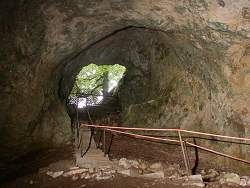
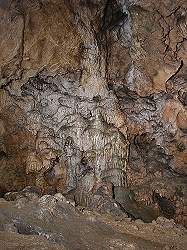
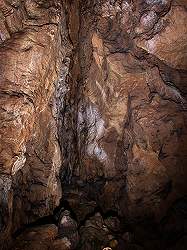
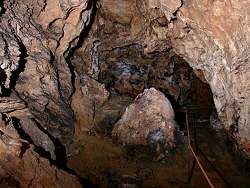
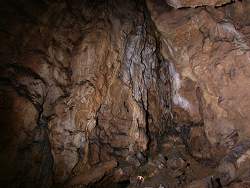
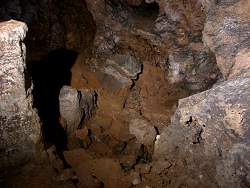
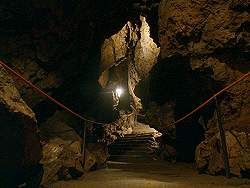
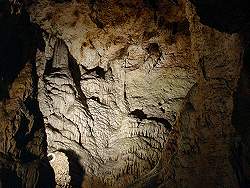
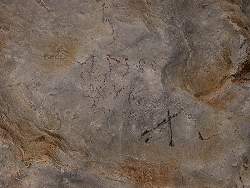
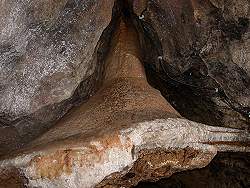
The Sontheimer Höhle (Cave of Sontheim) is probably the oldest show cave in the Schwäbische Alb (Swabian Jura), and was formerly also known as Sontheim Erdloch. The first official cave visit probably took place in 1516 during the visit of Duke Ulrich von Württemberg (*1487-✝1550). The visit is documented, but an exact date has not been handed down. It is known, however, that the Duke was in Blaubeuren from 17 to 20-OCT-1516 to attend the negotiations against Cardinal Lang. A ban had been imposed on the latter, which was lifted with this trial. On both his outward and return journeys, the Duke chose the route from Wiesensteig over the Alb, which took him past Sontheim both times. The Tiefental ends in the Achtal valley not far from Blaubeuren. It is conceivable that the visit took place on this journey. But what is known is that the cave was actually developed for the visit, the trail was equipped with wooden planks to make the visit more comfortable.
Sontheim Cave has long been famous for its Höhlenfeste (cave festivals). It is not known how long these cave festivals have been held, but they were first described in a book by Gustav Schwab in 1823, in which he wrote "Until about 1790, the farmers of Sontheim held an annual feast and dance in this cave (on Whit Monday)". So he, too, only reproduced stories told by the locals, and it is not clear whether the festivities actually took place in the rather cool cave or, as is customary today, on the forecourt. What is certain, however, is that the tradition was revived on 03-JUL-1825. The day of the cave festival was the only day of the year when the cave was illuminated, with torches and candles which were placed inside the cave. Therefore, the cave tours associated with the festival were very popular. Nevertheless, in the following years there was not every year a festival. It is said that after the 1841 festival there was a 16-year break until 1857, when a particularly large festival was held and the first cave guidebook was printed for this event.
The cave festival was originally held in July, on the Peter and Paul holiday. The reason was probably that the people of Sontheim have a special relationship with this saint, to whom the Sontheim Peter and Paul Church is dedicated. At the end of the 18th century, a few cave festivals were held on Whit Monday before there was a gap again. With the founding of the Sontheim Cave Association in 1956, the cave was developed and equipped with electric light, and opened to the public in 1957. Cave festivals were also held more frequently again, and finally the cave festival was held annually on Whit Sunday. It was quite unusual that the festival was held only on one day, which was probably due to the fact that the association was quite small. The cave restaurant was not completed until 1971 and in that year the combined cave festival and inauguration celebration lasted the whole weekend. Since 2004, the cave festival has been held on Whit Saturday and Sunday.
The cave festival has a special feature to offer. Only on this day is it possible to visit the Hintere Kohlhaldenhöhle. This not particularly large cavity is full of so-called candle stalagmites, which are slender stalagmites about 10 cm to 15 cm in diameter and one to two metres high. This cave was discovered a few years ago during the construction of a new generator house. It is not part of the regular guided tour to protect the stalactites and the bats living in the cave. The stalactites are of exceptional beauty and remain in this pristine state, not least because of the limited opportunities to visit.
The Sontheim Cave is entered through a large portal that leads into the largest hall of the cave. This entrance is artificial; the historic entrance was through a much smaller passageway at the location of the seating area to the right of the portal. Today it is filled in and built over, but from the inside it can still be made out with a lot of good will. However, Duke Ulrich von Württemberg still used this entrance in 1516. Somewhat later, the exact date is unknown, an attempt was made to create a more convenient entrance next to it. This was a resounding success, so to speak. After a short excavation, the already very thin cave roof collapsed and the large portal formed. This collapse doline would certainly also have formed naturally; the neighbouring Tiefental (deep valley) had already eroded the ceiling. One day it would have collapsed at the thinnest point anyway.
Weathering in the entrance area has widened this opening even more, and so today you go through a large portal and down a steep staircase over the debris of the collapse. Once on the floor of the hall, on the left you can see a cave passage leading east. After a constriction, closed by a bat gate, it widens again and leads continuously downhill until it ends after about 150 m. The cave does not have a second entrance, so the tour group turns around and climbs back up the same way. The way back is more interesting, because different parts of the cave catch the eye uphill and the cave looks more imposing when looking upwards.
The main passage, while not as huge as the entrance hall, is generally quite high. Several shafts reach upwards for about 25 metres. It has beautiful sinter formations in many places. The Schlußhalle (Final Hall) is the second-largest chamber in the cave and probably has the most unusual stalagmite in the cave, the Glocke (Bell). This stalagmite once grew on a sedimentary fill in the cave, which was later cleared out. Since it had also connected to the wall, it remained in place and today appears to be levitating. Such "false floors" are quite common in caves, but the bell-shaped stalagmite makes it a particularly photogenic spot.
The cave was once famous for its huge bat colony. In the 1950s and 60s, between 100 and 400 bats were ringed in the cave each year. Empirical data, especially after more recent research, suggests that far more bats hibernated in inaccessible places. Probably there were several thousand. In the following years, however, farming was intensified, and due to the decline in the food base and the accumulation of insecticides in the food chain, the population declined dramatically. Between 1969 and 1973, the population declined to one sixth. It was not until 1980 that conservation measures took effect and the population slowly but steadily recovered. Today, the population has fundamentally recovered, but the numbers of the 1950s are still not being reached again.
The cave climate is influenced by the large entrance portal and the much deeper cave. It is a classic cold trap, the cold outside air is heavy and flows into the cave in winter, icicles form because the entrance room cools down below 0 °C. The ice remains until spring, even if it is already getting warmer outside, but it does not last until summer. In summer, the entrance hall may become warmer than common for Alb caves, which is primarily due to the sun shining into the cave in the afternoons and evenings. However, behind the bat gate comes a narrow point where the visitor can actually feel a drop in temperature. This is the transition from the area that is still influenced by the outside to the real cave area that has the same temperature all year round.
And here you can also measure another special feature of the cave: the temperature of 7 °C. On the Alb, 8 °C is normal, which corresponds to the long-term average of the outside temperature. But due to the cold trap effect, the temperature is somewhat lower. The bats appreciate this. The lower the temperature, the stronger their hibernation, the less energy they need and the more likely they are to survive the winter. This is certainly one of the reasons why this cave is so popular with bats. But they are not only here to hibernate, they are also in the cave during the summer. This was only recognised in the last 20 years after a light barrier was installed at the bat gate, which not only counted the bats but also recorded their direction of passage. In late August, the association offers so-called Bat Nights, when the weather is fine and there are lots of insects in the air, the cave portal is full of bats at sunset time.
The cave was not visited in the Stone Age, although the UNESCO World Heritage Caves of the Blautal are only a few kilometres away. However, no prehistoric finds have been made. This is certainly due to the fact that the hunting prey passed through the Blautal, but not the Tiefental. However, the cave was definitely visited later on, the find of an early-Halemanic burial from the 3rd or 4th century is exceptional. The double grave from the Merovingian period was excavated in 1977 during a dig by the Tübingen State Office for the Preservation of Monuments. Celtic remains were also found.
Another special feature of the cave is that it was one of the first show caves in Germany to be converted to full LED lighting. In 2010, a fundamental renovation of the tour path had become urgently necessary after more than 50 years. The lighting system was completely renewed and the path was rebuilt in more than 600 volunteer hours.

|
| Sontheimer Höhle Gallery |
- See also
 Sontheimer Höhle - Laichinger Tiefenhöhle by Tony Oldham (1965).
Sontheimer Höhle - Laichinger Tiefenhöhle by Tony Oldham (1965). Search DuckDuckGo for "Sontheimer Höhle"
Search DuckDuckGo for "Sontheimer Höhle" Google Earth Placemark
Google Earth Placemark OpenStreetMap
OpenStreetMap Sontheimer Höhle
Sontheimer Höhle  - Wikipedia (visited: 06-OCT-2011)
- Wikipedia (visited: 06-OCT-2011) Willkommen in der Sontheimer Höhle, official website
Willkommen in der Sontheimer Höhle, official website  (visited: 06-OCT-2011)
(visited: 06-OCT-2011) Kubische Panoramen - Schlusshalle
Kubische Panoramen - Schlusshalle  (visited: 06-OCT-2011)
(visited: 06-OCT-2011)
 Index
Index Topics
Topics Hierarchical
Hierarchical Countries
Countries Maps
Maps